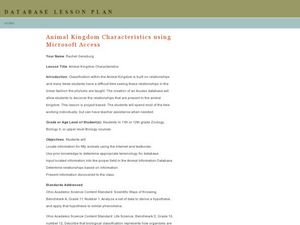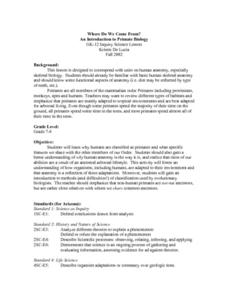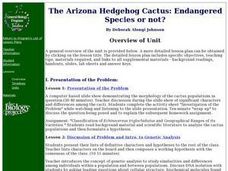Curated Video
What Is A Species? | Evolution | Biology | FuseSchool
Carl Linnaeus classified all living things into groups based upon their physical features. His system placed organisms with the most similar characteristics together in a group he called the “species”. A species is defined as all...
Bozeman Science
Communities
Paul Andersen explains the major classification terms in ecology and how a community can be measured by species composition and species diversity. The symbiosis of leaf cutter ants is included. The podcast ends with a discussion of...
Curated Video
What Is A Species?
Carl Linnaeus classified all living things into groups based upon their physical features. His system placed organisms with the most similar characteristics together in a group he called the “species”. A species is defined as all...
Curated OER
Classification
Tenth graders explain how organisms are classified according to similarities. In this biology lesson, 10th graders research on five different organisms of their choice. They prepare a report and presentation about them which they share...
University of Hawaiʻi
Taxonomy and Me!
Taxonomy is the study of organisms and how you phylum. Three biology activities are included, helping scholars understand four of the six kingdoms, specifically Protista, Plantae, Fungi, and Animalia. Scholars observe and classify in...
Curated OER
Animal Kingdom Characteristics using Microsoft Access
Students create a computer database to discover relationships present in the Animal Kingdom. In this classification lesson, students enter data into a Microsoft Access database. They answer questions on a worksheet and create a visual...
Curated OER
Introduction to Classification
Fourth graders design a classification system to categorize animate and inanimate objects. They discuss the advantages of grouping things as they classify buttons, leaves, shells.
Curated OER
Reading the River - Biological Classification
Youngsters create a list of grocery store items and then work together to categorize them as if they were setting up the shelves of the market. Then they are given a box of miscellaneous objects to practice categorizing. With these two...
Illinois Department of Natural Resources
Section One: What is Biodiversity?
Four intriguing and scientific activities invite learners to explore the natural resources of their town. The activities cover concepts such as genetic traits, organizing species in a taxonomy, the differences between different species...
Curated OER
Kingdom Animalia ~ A Look at the Five Major Classes
Biological taxonomy masters examine the five main classes under phylum chordata. Pupils compare and contrast the identifying characteristics of the various organisms. They explain why taxonomy is important in classifying organisms. You...
Be Smart
Is This A New Species?!
Which makes a better name for a new species: Hermit Crab Caterpillar or Sir Leafs-a-Lot? Exploring a rainforest in Peru, the video helps viewers discover a unique species as part of a larger biology playlist. As scientists learn more...
Alliance Theater
The Jungle Book Post-Show STEAM Lesson
An ecosystem is really just the flow of energy through many different living organisms. A study of Rudyard Kipling's The Jungle Book leads to an environmental science activity in which learners study how various factors can affect...
Curated OER
Taxonomy
Students analyze the complexity of organism classifications based on certain criteria. In this classifying organisms instructional activity students study taxonomy and gather information and leaves to do their own experiment on...
Curated OER
Classification of Cerealites
Students create a dichotomous key. In this categorizing lesson, students create a dichotomous key for different types of cereal. Students classify the cereal into groups such as flakes and cereal with holes. Students discuss their...
Curated OER
Human Evolution: Biology, Bones
Learners will love a weeks worth of bone study. They use bones and characteristics of bones to explore the evolution of hominoids. Bones are compared, categorized, and considered. A great way to bring physical anthropology and material...
Curated OER
Around-The-World-Zoo
Junior biologists design and maintain a website about a zoo by researching, classifying, and providing the correct habitats for the animals they choose to have in their zoo. This technology-based project can last over an entire semester...
FuseSchool
How Are Organisms Classified?
Understanding classification takes a little imagination! Show your biology class why it is important to keep things organized using a simple video that is part of the Fuse School Evolution playlist. Topics covered include the creator of...
ARKive
Species Discovery
How do you classify a newly discovered species? Learners view a presentation and complete research about biodiversity and the classification hierarchy. The lesson includes activities with dichotomous keys and work on classifying both...
Curated OER
Where Do We Come From? An Introduction to Primate Biology
Seventh graders explore skeletal biology. Through a discussion and video observation, 7th graders investigate how the anatomy is adapted to the environment. Students study primates and explore their characteristics and behaviors.
Curated OER
Ecology and Evolution
Learners identify the different taxonomic classifications of organisms. In this biology instructional activity, students create their own organisms and make some changes according to environmental conditions. They present their work in...
Curated OER
An Introduction to Primate Biology
Students examine why humans are classified as primates and what features they share with other members of the order. In this investigative lesson plan students divide into groups and complete their lab station.
Curated OER
The Arizona Hedgehog Cactus: Endangered Species or not?: Biology, Plants
In this lesson plan students will study the: "Classification of Echinocereus triglochidiatus and Geographical Ranges of its Varieties." Students read background material and scientific literature to analyze the cactus populations and...
Curated OER
What Is a Species?
Young scholars are able to recognize that scientists use different definitions of species. They are able to assess the strengths and limitations of species definitions depending on their context. Students are able to use definitions of...
Curated OER
Summer: Getting the Bugs Out
Students compare and contrast classification systems used throughout the world. They also examine the importance of preserving biological diversity.
























